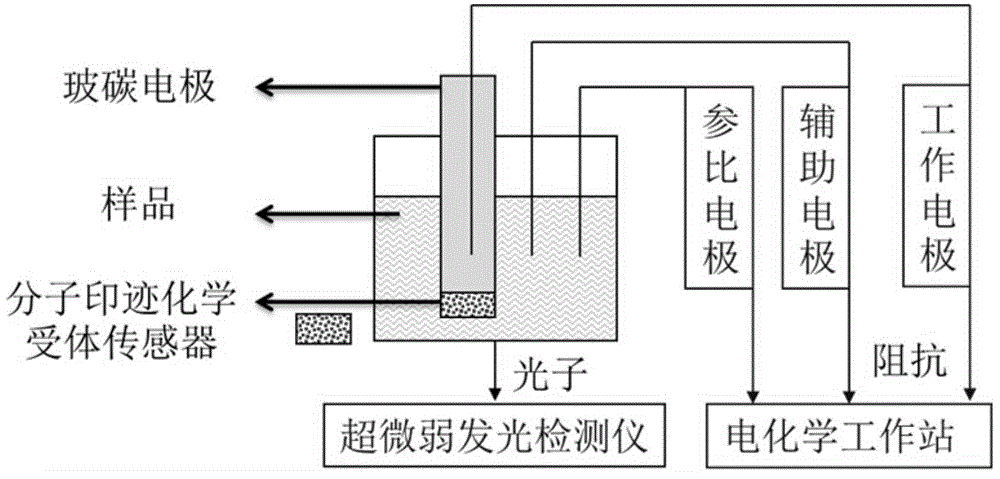Algal toxin molecular imprinting chemoreceptor sensor as well as preparation method and application thereof
A technology of chemical receptors and molecular imprinting, applied in the direction of material electrochemical variables, etc., can solve the problems of poor anti-interference ability, achieve the effect of improving stability, reducing costs, and overcoming interference
- Summary
- Abstract
- Description
- Claims
- Application Information
AI Technical Summary
Problems solved by technology
Method used
Image
Examples
Embodiment 1
[0025] 1.1 Preparation of molecularly imprinted chemical receptor sensor:
[0026] First, take microcystin, gonylin, acrylic acid, ethylene glycol dimethacrylate and benzoin ethyl ether and mix them according to the molar ratio of 1:1:50:20:1, and mix them uniformly to form a mixed solution. solution at 4°C overnight to make it fully functional.
[0027] Secondly, the glassy carbon electrode is sequentially made of α-Al with a particle size of 1.0 μm, 0.3 μm and 0.05 μm 2 o 3 The powder was polished to the mirror surface, and after cleaning, the glassy carbon electrode was blown dry with nitrogen gas, and 8 μL of the above mixed liquid was drip-coated on the glassy carbon electrode, and irradiated with a UV lamp at 30 cm for 25 min to initiate polymerization to obtain a molecularly imprinted film.
[0028] Finally, the molecularly imprinted membrane was rinsed with 15 mL of 40% ethanol-water mixed solvent and 15 mL of deionized water at a rate of 1 mL / min to remove template ...
Embodiment 2
[0033] 2.1 Preparation of algal toxin molecularly imprinted chemical receptor sensor:
[0034] First, mix microcystin, gonylin, 4-vinylpyridine, N'N'-methylenebisacrylamide, and benzoin ethyl ether in a molar ratio of 1:1:40:15:1.5, and mix well A mixed solution was formed, and the mixed solution was kept overnight at 4° C. to allow it to fully function.
[0035] Secondly, the glassy carbon electrode is sequentially made of α-Al with a particle size of 1.0 μm, 0.3 μm and 0.05 μm 2 o 3 The powder was polished to the mirror surface, and after cleaning, the glassy carbon electrode was blown dry with nitrogen gas, and 12 μL of the above mixed liquid was drip-coated on the glassy carbon electrode, and irradiated with a UV lamp at 30 cm for 15 min to initiate polymerization to obtain a molecularly imprinted film.
[0036] Finally, the molecularly imprinted membrane was rinsed with 15 mL of 50% ethanol-water mixed solvent and 15 mL of deionized water at a rate of 1 mL / min to remove...
Embodiment 3
[0041] 3.1 Preparation of algal toxin molecularly imprinted chemical receptor sensor:
[0042] First, mix microcystin, gonylin, 4-vinylpyridine, N'N'-methylenebisacrylamide, and benzoin ethyl ether in a molar ratio of 1:1:20:10:0.5, and mix well A mixed solution was formed, and the mixed solution was kept overnight at 4° C. to allow it to fully function.
[0043] Secondly, the glassy carbon electrode is sequentially made of α-Al with a particle size of 1.0 μm, 0.3 μm and 0.05 μm 2 o 3 The powder was polished to the mirror surface, and after cleaning, the glassy carbon electrode was blown dry with nitrogen gas, and 10 μL of the above mixed liquid was drip-coated on the glassy carbon electrode, and irradiated with a UV lamp at 25 cm for 10 min to initiate polymerization to obtain a molecularly imprinted film.
[0044] Finally, the molecularly imprinted membrane was rinsed with 15 mL of 50% ethanol-water mixed solvent and 15 mL of deionized water at a rate of 1 mL / min to remove...
PUM
| Property | Measurement | Unit |
|---|---|---|
| recovery rate | aaaaa | aaaaa |
Abstract
Description
Claims
Application Information
 Login to View More
Login to View More - R&D
- Intellectual Property
- Life Sciences
- Materials
- Tech Scout
- Unparalleled Data Quality
- Higher Quality Content
- 60% Fewer Hallucinations
Browse by: Latest US Patents, China's latest patents, Technical Efficacy Thesaurus, Application Domain, Technology Topic, Popular Technical Reports.
© 2025 PatSnap. All rights reserved.Legal|Privacy policy|Modern Slavery Act Transparency Statement|Sitemap|About US| Contact US: help@patsnap.com


